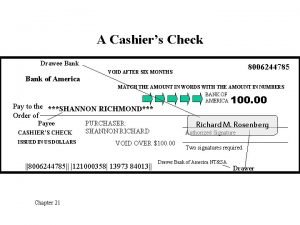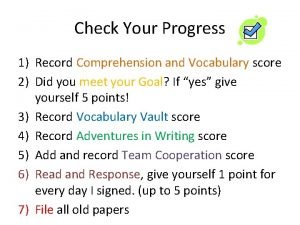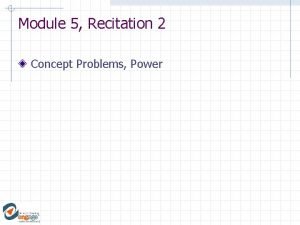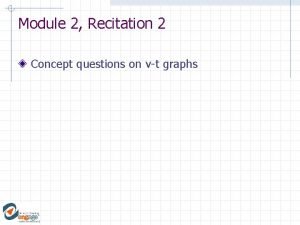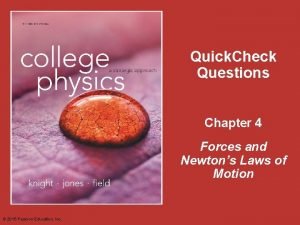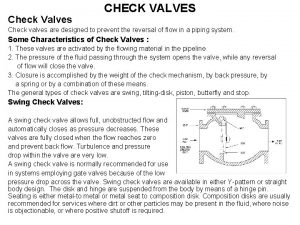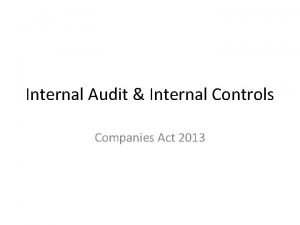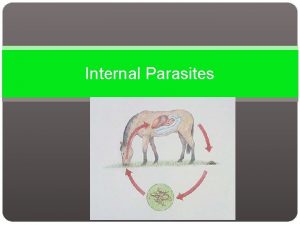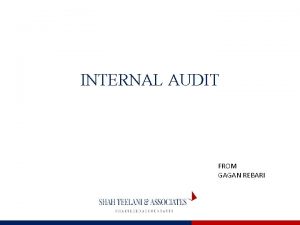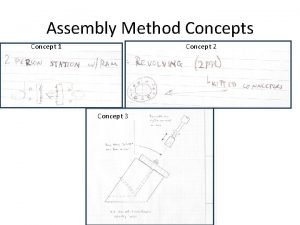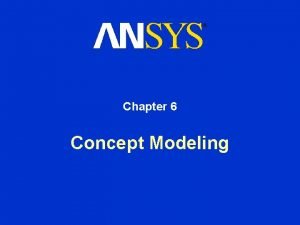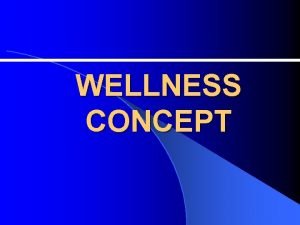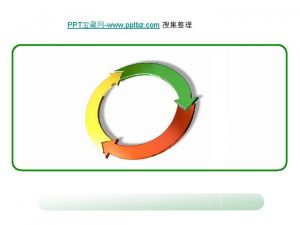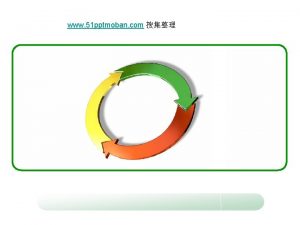Concept Check What is the change in internal



















































- Slides: 51


Concept Check What is the change in internal energy of a system that gives off 89 J of heat and has 531 J of work done on it? q = -89 J w = +531 J Copyright © Cengage Learning. All rights reserved ΔE = (-89 J) + (+531 J) = 442 J 2

Concept Check Determine the sign of E for each of the following with the listed conditions: a) An endothermic process that performs work. § |work| > |heat| Δ E = negative § |work| < |heat| Δ E = positive b) Work is done on a gas and the process is exothermic. § |work| > |heat| Δ E = positive § |work| < |heat| Δ E = negative Copyright © Cengage Learning. All rights reserved 3

Homework: Read 10. 4 and 10. 5 and do self-checks


At constant pressure, the change in enthalpy (ΔH°) of a system is equal to the energy flow as heat. Enthalpy is a state function, so the change in H is Example: How much heat is released whenof 5. 02 gthe hydrogen gas is reacted with oxygen independent pathway. gas? 2 H 2 (g) + O 2 (g) 2 H 2 O (l) ΔH° = -572 k. J/mol

Exercise The overall reaction in a commercial heat pack can be represented as: 4 Fe (s) + 3 O 2 (g) 2 Fe 2 O 3 (s) ΔH = – 1652 k. J a. How much heat is released when 4. 00 moles of iron is reacted with excess oxygen gas? Copyright © Cengage Learning. All rights reserved 7

Exercise The overall reaction in a commercial heat pack can be represented as: 4 Fe (s) + 3 O 2 (g) 2 Fe 2 O 3 (s) ΔH = – 1652 k. J b. How much heat is released when 1. 00 moles of iron (III) oxide is produced? Copyright © Cengage Learning. All rights reserved 8

Exercise The overall reaction in a commercial heat pack can be represented as: 4 Fe (s) + 3 O 2 (g) 2 Fe 2 O 3 (s) ΔH = – 1652 k. J c. How many moles of iron are reacted in excess oxygen to produce 533 kilojoules of energy? Copyright © Cengage Learning. All rights reserved 9

Exercise The overall reaction in a commercial heat pack can be represented as: 4 Fe (s) + 3 O 2 (g) 2 Fe 2 O 3 (s) ΔH = – 1652 k. J d. How much heat is released when 1. 00 g of iron is reacted with excess oxygen gas? Copyright © Cengage Learning. All rights reserved 10

Exercise The overall reaction in a commercial heat pack can be represented as: 4 Fe (s) + 3 O 2 (g) 2 Fe 2 O 3 (s) ΔH = – 1652 k. J e. How much heat is released when 10. 0 g Fe and 2. 00 g of O 2 are reacted? Copyright © Cengage Learning. All rights reserved 11

Exercise Consider the combustion of propane: C 3 H 8(g) + 5 O 2(g) → 3 CO 2(g) + 4 H 2 O(l) ΔH = – 2221 k. J Assume that all of the heat comes from the combustion of propane. Calculate ΔH in which 5. 00 g of propane is burned in excess oxygen at constant pressure. – 252 k. J Copyright © Cengage Learning. All rights reserved 12



• The common energy units for heat are the calorie and the joule. § calorie – the amount of energy (heat) required to raise the temperature of one gram of water 1 o. C. § Joule – 1 calorie = 4. 184 joules Copyright © Cengage Learning. All rights reserved 15

Example Convert 60. 1 cal to joules. Copyright © Cengage Learning. All rights reserved 16

Energy (Heat) Required to Change the Temperature of a Substance Depends On: 1. The amount of substance being heated (number of grams). 2. The temperature change (number of degrees). 3. The identity of the substance. § Specific heat capacity is the energy required to change the temperature of a mass of one gram of a substance by one Celsius degree. Copyright © Cengage Learning. All rights reserved 17


Specific Heat Capacities of Common Substances

Calorimetry Science of measuring heat Specific heat capacity: § The energy required to raise the temperature of one gram of a substance by one degree Celsius. • Molar heat capacity: § The energy required to raise the temperature of one mole of substance by one degree Celsius. • • Copyright © Cengage Learning. All rights reserved 20

Q = smΔT

Calorimetry • Energy (heat) = s × m × ΔT s = specific heat capacity (J/°C·g) m = mass (g) ΔT = change in temperature (°C) Copyright © Cengage Learning. All rights reserved 22




= -7900 J -1. 9 kcal

Section 6. 1 The Nature of Energy Concept Check What is the change in internal energy of a system that gives off 89 J of heat and has 531 J of work done on it? q = -89 J w = +531 J ΔE = (-89 J) + (+531 J) = 442 J Return to TOC Copyright © Cengage Learning. All rights reserved 27

Section 6. 1 The Nature of Energy Concept Check Determine the sign of E for each of the following with the listed conditions: a) An endothermic process that performs work. § |work| > |heat| Δ E = negative § |work| < |heat| Δ E = positive b) Work is done on a gas and the process is exothermic. § |work| > |heat| Δ E = positive § |work| < |heat| Δ E = negative Return to TOC Copyright © Cengage Learning. All rights reserved 28

Section 6. 1 The Nature of Energy Homework: Read 10. 4 and 10. 5 and do self-checks Return to TOC

Section 6. 1 The Nature of Energy Return to TOC

Section 6. 2 Enthalpy and Calorimetry At constant pressure, the change in enthalpy (ΔH°) of a system is equal to the energy flow as heat. Enthalpy is a state function, so the change in H is independent of the pathway. Example: How much heat is released when 5. 02 g hydrogen gas is reacted with oxygen gas? 2 H 2 (g) + O 2 (g) 2 H 2 O (l) ΔH° = -572 k. J/mol Return to TOC

Section 6. 2 Enthalpy and Calorimetry Exercise The overall reaction in a commercial heat pack can be represented as: 4 Fe (s) + 3 O 2 (g) 2 Fe 2 O 3 (s) ΔH = – 1652 k. J a. How much heat is released when 4. 00 moles of iron is reacted with excess oxygen gas? Return to TOC Copyright © Cengage Learning. All rights reserved 32

Section 6. 2 Enthalpy and Calorimetry Exercise The overall reaction in a commercial heat pack can be represented as: 4 Fe (s) + 3 O 2 (g) 2 Fe 2 O 3 (s) ΔH = – 1652 k. J b. How much heat is released when 1. 00 moles of iron (III) oxide is produced? Return to TOC Copyright © Cengage Learning. All rights reserved 33

Section 6. 2 Enthalpy and Calorimetry Exercise The overall reaction in a commercial heat pack can be represented as: 4 Fe (s) + 3 O 2 (g) 2 Fe 2 O 3 (s) ΔH = – 1652 k. J c. How many moles of iron are reacted in excess oxygen to produce 533 kilojoules of energy? Return to TOC Copyright © Cengage Learning. All rights reserved 34

Section 6. 2 Enthalpy and Calorimetry Exercise The overall reaction in a commercial heat pack can be represented as: 4 Fe (s) + 3 O 2 (g) 2 Fe 2 O 3 (s) ΔH = – 1652 k. J d. How much heat is released when 1. 00 g of iron is reacted with excess oxygen gas? Return to TOC Copyright © Cengage Learning. All rights reserved 35

Section 6. 2 Enthalpy and Calorimetry Exercise The overall reaction in a commercial heat pack can be represented as: 4 Fe (s) + 3 O 2 (g) 2 Fe 2 O 3 (s) ΔH = – 1652 k. J e. How much heat is released when 10. 0 g Fe and 2. 00 g of O 2 are reacted? Return to TOC Copyright © Cengage Learning. All rights reserved 36

Section 6. 2 Enthalpy and Calorimetry Exercise Consider the combustion of propane: C 3 H 8(g) + 5 O 2(g) → 3 CO 2(g) + 4 H 2 O(l) ΔH = – 2221 k. J Assume that all of the heat comes from the combustion of propane. Calculate ΔH in which 5. 00 g of propane is burned in excess oxygen at constant pressure. – 252 k. J Copyright © Cengage Learning. All rights reserved Return to TOC 37

Section 6. 2 Enthalpy and Calorimetry Return to TOC

Section 6. 2 Enthalpy and Calorimetry Return to TOC

Section 6. 2 Enthalpy and Calorimetry • The common energy units for heat are the calorie and the joule. § calorie – the amount of energy (heat) required to raise the temperature of one gram of water 1 o. C. § Joule – 1 calorie = 4. 184 joules Return to TOC Copyright © Cengage Learning. All rights reserved 40

Section 6. 2 Enthalpy and Calorimetry Example Convert 60. 1 cal to joules. Return to TOC Copyright © Cengage Learning. All rights reserved 41

Section 6. 2 Enthalpy and Calorimetry Energy (Heat) Required to Change the Temperature of a Substance Depends On: 1. The amount of substance being heated (number of grams). 2. The temperature change (number of degrees). 3. The identity of the substance. § Specific heat capacity is the energy required to change the temperature of a mass of one gram of a substance by one Celsius degree. Return to TOC Copyright © Cengage Learning. All rights reserved 42

Section 6. 2 Enthalpy and Calorimetry Return to TOC

Section 6. 2 Enthalpy and Calorimetry Specific Heat Capacities of Common Substances Return to TOC

Section 6. 2 Enthalpy and Calorimetry • • Science of measuring heat Specific heat capacity: § The energy required to raise the temperature of one gram of a substance by one degree Celsius. • Molar heat capacity: § The energy required to raise the temperature of one mole of substance by one degree Celsius. Return to TOC Copyright © Cengage Learning. All rights reserved 45

Section 6. 2 Enthalpy and Calorimetry Q = smΔT Return to TOC

Section 6. 2 Enthalpy and Calorimetry • Energy (heat) = s × m × ΔT s = specific heat capacity (J/°C·g) m = mass (g) ΔT = change in temperature (°C) Return to TOC Copyright © Cengage Learning. All rights reserved 47

Section 6. 2 Enthalpy and Calorimetry Return to TOC

Section 6. 2 Enthalpy and Calorimetry Return to TOC

Section 6. 2 Enthalpy and Calorimetry Return to TOC

Section 6. 2 Enthalpy and Calorimetry = -7900 J -1. 9 kcal Return to TOC
 System of internal controls
System of internal controls Audit report of a company
Audit report of a company Behavior check in check out sheet
Behavior check in check out sheet Behavior check in check out sheet
Behavior check in check out sheet Check in check out
Check in check out Check in check out system for students
Check in check out system for students Jobbank
Jobbank Dda algorithm advantages and disadvantages
Dda algorithm advantages and disadvantages Check in check out intervention
Check in check out intervention Check in and check out intervention
Check in and check out intervention Velocity and acceleration quick check
Velocity and acceleration quick check Endorsing a check to someone else
Endorsing a check to someone else Check my progress vocabulary check
Check my progress vocabulary check Internal check regarding wages
Internal check regarding wages Ccq questions examples
Ccq questions examples Module 2 concept check
Module 2 concept check Campbell biology concept check answers
Campbell biology concept check answers Module 2 concept check
Module 2 concept check 10 year old sarah stands on a skateboard
10 year old sarah stands on a skateboard 3-3 rate of change and slope
3-3 rate of change and slope Change in energy quick check
Change in energy quick check Hát kết hợp bộ gõ cơ thể
Hát kết hợp bộ gõ cơ thể Slidetodoc
Slidetodoc Bổ thể
Bổ thể Tỉ lệ cơ thể trẻ em
Tỉ lệ cơ thể trẻ em Chó sói
Chó sói Chụp phim tư thế worms-breton
Chụp phim tư thế worms-breton Chúa yêu trần thế
Chúa yêu trần thế Các môn thể thao bắt đầu bằng từ đua
Các môn thể thao bắt đầu bằng từ đua Thế nào là hệ số cao nhất
Thế nào là hệ số cao nhất Các châu lục và đại dương trên thế giới
Các châu lục và đại dương trên thế giới Công thức tiính động năng
Công thức tiính động năng Trời xanh đây là của chúng ta thể thơ
Trời xanh đây là của chúng ta thể thơ Mật thư tọa độ 5x5
Mật thư tọa độ 5x5 Làm thế nào để 102-1=99
Làm thế nào để 102-1=99 Phản ứng thế ankan
Phản ứng thế ankan Các châu lục và đại dương trên thế giới
Các châu lục và đại dương trên thế giới Thể thơ truyền thống
Thể thơ truyền thống Quá trình desamine hóa có thể tạo ra
Quá trình desamine hóa có thể tạo ra Một số thể thơ truyền thống
Một số thể thơ truyền thống Cái miệng nó xinh thế
Cái miệng nó xinh thế Vẽ hình chiếu vuông góc của vật thể sau
Vẽ hình chiếu vuông góc của vật thể sau Nguyên nhân của sự mỏi cơ sinh 8
Nguyên nhân của sự mỏi cơ sinh 8 đặc điểm cơ thể của người tối cổ
đặc điểm cơ thể của người tối cổ V cc
V cc Vẽ hình chiếu đứng bằng cạnh của vật thể
Vẽ hình chiếu đứng bằng cạnh của vật thể Fecboak
Fecboak Thẻ vin
Thẻ vin đại từ thay thế
đại từ thay thế điện thế nghỉ
điện thế nghỉ Tư thế ngồi viết
Tư thế ngồi viết Diễn thế sinh thái là
Diễn thế sinh thái là






